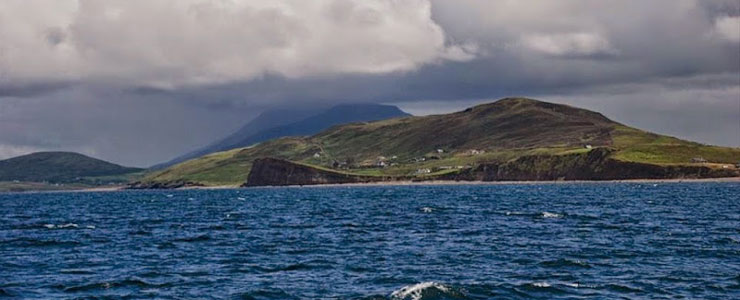Clare Island in Co. Mayo

Situated at the mouth of Clew Bay, Clare Island or “the gem of the Western Isles” is the largest island in the bay. It is located 6 km off the mainland and is 8 km long and 5 km wide.
It rises out of the sea with the stunning silhouette of Knockmore or Croaghmore 465 metres above the sea level. Along the northern shore, the Atlantic Ocean carved spectacular cliffs rated among the highest in Ireland and recognised internationally as an area of scientific importance. Here large colonies of sea birds and rare arctic-alpine flora can be found in remarkable abundance.
People have lived here from at least 3500 BC and have left traces behind them such as megalithic tombs, promontory forts, walls and open-air cooking sites.
Just before the Great Famine of the mid-1840s 1600 people lived on the island. Old potato ridges, or 'lazy beds' as they are sometimes referred to, can be seen along the landscape. These 'lazy beds' are historic evidence of the 19th century population explosion and subsequent famine when the island's population was reduced by half. Nowadays its normal population is less than 150 people.
During the years 1909 and 1911 Clare Island was the subject of one of the most important natural history surveys undertaken in Ireland - The Clare Island Survey, led by Robert Lloyd Praeger with the Royal Irish Academy.
More than 100 scientists from Ireland, Denmark, Germany, Switzerland and Britain collected the most comprehensive data about island’s flora and fauna in aim to discover differences between island and mainland species supporting Darwinism. 3500 plants species (585 new to Ireland) and 5200 species of fauna (1200 new to Ireland) were identified. This work of the island survey has a big value today.
The Royal Irish Academy has recently repeated the original survey and discovered dramatic changes, many species have come and gone since Praeger’s day. The number of plants has decreased, but the bird species have grown. After the New Survey of Clare Island eight volumes were published by the Royal Irish Academy providing an unique overview of the island’s Archaeology, History and Culture, Botany, Geology and Zoology.
The RIA explained about Clare Island: “In many ways this beautiful island is a microcosm of all that is the West of Ireland : unpolluted, yet sensitive to fundamental global changes.”
